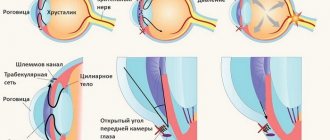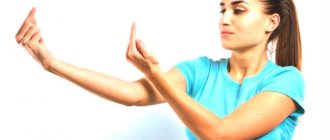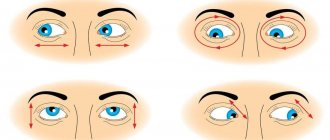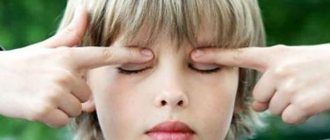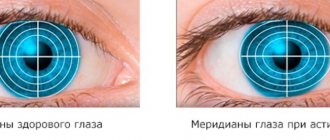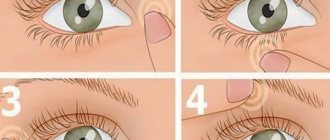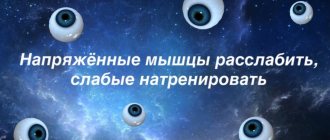The essence of the method that restores vision
The structure of the Norbekov vision restoration method involves psychological exercises similar to meditation, as well as simple exercises aimed at training the eye muscles using a special table. This table allows you not only to exercise, but also to check your visual acuity, as well as track the results of your exercises.
The fundamental principle of the technique states that you need to give up thoughts about your illness and weakness, and feel like a strong and healthy person. Norbekov suggests using willpower to set the body in a positive way.
To obtain the mood necessary for healing, before performing the exercises, you need to straighten your back and straighten your shoulders, and also relax the facial muscles. All exercises should be performed with a wide smile.
The technique developed by Norbekov is controversial and has no scientific evidence of its effectiveness. However, many people claim that they were able to restore their vision thanks to its use.
Rules for performing eye exercises
In order to get maximum efficiency from performing eye gymnastics, and especially not to harm yourself, you need to follow certain rules:
- you cannot perform exercises without desire;
- facial and neck muscles should not be involved in the process;
- the eyes should be relaxed as much as possible;
- you should move your eyeballs smoothly and gently;
- Do not allow eye fatigue;
- you should breathe evenly and calmly;
- Before performing exercises, glasses and contact lenses must be removed.
Performing an exercise on the principle of “just to do it” will not bring any benefit. You need to set yourself up to achieve your goal and remember that the exercises are performed to help not someone else, but yourself.
The muscles of the neck and face should be as relaxed as possible. They do not take any part in performing eye exercises. This may not work right away, so relaxation of the facial muscles will have to be practiced.
When performing exercises to move the eyeball, they should be performed smoothly. No jerking is allowed.
Since the exercises, according to the method, are performed repeatedly, the eyes may get tired, especially at the very beginning of classes. In this case, you should take a short break and give your eyes a rest. During eye exercises, you should breathe evenly and not too deeply, since deep breathing causes the muscles of the cervical region to tense.
Neck warm-up
All exercises are performed without glasses or contact lenses. Before starting classes, you should sit for a while with your eyes closed and try to relax as much as possible.
Contraindications
There are a number of contraindications for using Norbekov’s exercises:
- pregnancy;
- psychological disorders;
- oncological diseases;
- recent heart attack or stroke;
- heart disease;
- hypertension.
Recommendations for proper performance of gymnastics
Eye exercises according to Norbekov must be performed using certain rules:
- When training the eye muscles, you should avoid head movements and ensure that only the eyeballs are involved in the exercises.
- Exercise should not lead to significant eye strain. If you feel tired, you should relax and blink.
- It is necessary to follow the sequence of exercises proposed by the author.
- A positive result is possible only with the correct psychological attitude.
- You should carefully monitor your posture.
The effectiveness of eye exercises for glaucoma
Gymnastics is used as an additional method of therapy. The health event promotes rapid relief from increased intraocular pressure, improves microcirculation and muscle tone of the visual analyzer.
Special exercises are performed at the workplace, at home and in any convenient place if discomfort or asthenopia occurs. There is no need to buy additional equipment; a pencil or pen will always be at hand.
It is contraindicated to make sudden movements of the head or eyes. Do the exercises strictly according to the instructions, based on your own feelings.
The effectiveness of gymnastics:
- relieving symptoms of asthenopia;
- prevention of glaucoma;
- preventing the development of the disease;
- strengthening the functioning of the optic nerve;
- improvement of visual perception;
- increasing the stability of the eye.
Gymnastics should be carried out according to a complex agreed upon with the ophthalmologist. Simultaneously with exercise, use medications and maintain proper nutrition. These methods of therapy cannot be neglected. Eye exercises alone will not help prevent the development of pathology; an integrated approach to treatment is important.
For myopia
Eye exercises according to Norbekov are applicable for people with medium and low myopia.
Exercises according to Norbekov for eyes with myopia
Sequence of classes:
- It is necessary to straighten your back and straighten your shoulders. The eyes should alternately move as far as possible to the left and right. The head should remain motionless.
- With your eyes you need to draw an imaginary number 8 in different directions.
- The focus of both eyes is placed on the tip of the nose. Then the eyes concentrate on the bridge of the nose, while you need to try to see objects located to the left and right of the person practicing. The lesson involves 8 approaches.
- The head is in a straight, motionless position, and the eyes rise to the maximum possible height, then drop as low as possible. 10 approaches to the exercise are used.
- The eyes draw a horizontal line from left to right, then vice versa. 8 repetitions of the exercise are performed. After it is completed, you need to blink.
- The eyes rotate clockwise on an imaginary watch dial, and then in the opposite direction.
Massage for eyes and eyelid area
Helps reduce IOP by improving lymph and blood flow. If in the morning, while washing your face, you rub your forehead more intensively, blink and raise your eyebrows, then blood circulation will increase in the eye area and your gaze will become more alert.
Method of massage:
- Start by stroking from the center of the forehead (between the eyebrows) to the temples. Rub with fingertips. Then go back and make tapping movements over the entire frontal part.
- Press on points along the entire surface of the brow ridge, then to the right and left of the bridge of the nose and in the outer corners.
- With severe asthenopia, it is easy to press on closed eyelids. Make vibrating movements 5–10 times. This helps reduce swelling and eliminate headaches.
It is recommended to undergo lymphatic drainage technique from a specialized massage therapist. Increases endurance, prevents deterioration of visual perception, and relieves swelling.
After completing the massage, it is recommended to wipe the treated area with an ice cube.
For farsightedness
Norbekov also created a complex that contains a system of exercises for the eyes for farsightedness:
- A person exercising straightens his back and keeps his head level. He needs to look at the ceiling with his eyes and mentally continue moving upward through his forehead. Next, the person doing the exercise looks down and mentally moves his gaze through the throat. The exercise is repeated 6-8 times.
- With your eyes you need to draw an imaginary inverted number 8. Eye movements should be smooth and consistent. After completing the exercise, you need to blink and relax. This exercise shows the greatest effectiveness in the treatment of senile farsightedness.
- The index fingers are placed near the nose. You need to focus your gaze on the fingers, which are gradually moving apart in different directions. In this case, the left eye should follow the left finger, and the right eye should follow the right. It is important to use mainly peripheral vision. Perform 3-4 approaches per exercise.
For astigmatism
Before starting eye exercises for astigmatism using the Norbekov method, you need to blink your eyes. And also perform a preparatory lesson in 5 approaches. It is as follows: the gaze moves up and down, the eyes blink, the gaze moves left and right.
Main gymnastic block:
- The eyes make movements in the shape of the number 8. The exercise is performed in 5 approaches in both directions.
- The eyes draw the number 8, which lies on its side. It is necessary to perform 5 approaches in both directions.
- The eyeballs rotate clockwise on the watch dial and counterclockwise. This activity can be performed with both open and closed eyes.
- The index finger is located 25 cm from the face. The right eye must be closed and the left eye concentrated on the finger. Then move your gaze into the distance. The procedure is repeated for the second eye.
After completing a set of exercises, you need to allow your eyes to rest. It is best to close your eyes and, relax, rest for about 5 minutes.
Palming
Complex relaxation is an effective way to prevent pathologies in the operation of the optical system. Palming has the same principle of restoring the visual analyzer as the sleep state. Only the patient can control the process and is conscious.
Technique:
- Cover your eyes with your palms. Completely isolate from light.
- Imagine any black objects in front of you until the light completely disappears.
- This approach helps to relax the overexcited endings of the optic nerve and relaxation of the visual analyzer.
If floaters appear before the eyes, it means that the eyes are very tense and the visual endings are overexcited. In complete darkness, dynamic electrical discharges are replaced by alpha waves.
The exercise is performed for 15–30 seconds. Then the time increases to 1 minute. The longer you give your eyes rest, the better.
For strabismus
Eye exercises according to Norbekov, aimed at correcting strabismus, are recommended to be carried out in a calm state, with your back straight and your shoulders straightened.
Set of exercises:
- Both eyes, brought together, move to the tip of the nose. Next, both eyes, avoiding tension, are transferred to the end of the room, while trying to see objects located on the sides. The exercise is repeated 7-8 times.
- The gaze should be placed on the tip of the nose, then forward, noticing objects on the sides. Next, the gaze is transferred to the bridge of the nose, then forward, not forgetting to use peripheral vision. In the last stage of this exercise, the gaze is directed to the space between the eyebrows, then forward, training lateral vision. The exercise is performed in 7-8 approaches.
All exercises are performed smoothly, without haste. At the end of the set of exercises, you need to relax your eyes and blink them.
Authors of eye exercise complexes
There are quite a large number of different techniques that were developed by ophthalmologists in different countries and at different times. There are as many of them as there are different diets for losing weight. Some of them, in fact, copy each other and differ only in minor nuances. In medicine, several sets of exercises are used that have proven their effectiveness over a long period. Doctors are quite wary of Tibetan and Taoist methods, as well as exercises from the yoga system. The founders of the most effective methods of eye exercises can be called the following authors:
- Bates;
- Norbekov;
- Zhdanov;
- Avetisov;
- Corbet.
Bates technique
was the first development. . The theoretical premises of William Bates were later recognized as incorrect, but some of his exercises provide effective help for many eye pathologies. The basis of Bates eye gymnastics are exercises to relax the eye muscles, as well as psychophysical training.
William Bates Method
In particular, Bates suggested that abandoning corrective optics and regular exercise would contribute to the complete restoration of vision. Soon the statement was partially refuted, because There were positive dynamics of improvements in visual function, but did not give 100% results.
The author suggests closing your eyes, mentally imagining beautiful landscapes, which causes relaxation of the eye muscles, or mentally drawing something on an imaginary sheet of paper.
Norbekov's eye exercises
This technique contains exercises to develop various eye muscles. Exercises for the eyes according to Norbekov - These are rotational movements of the eyeballs, orientation of the gaze up down and from left to right. Some exercises are designed to switch the eye's focus from near to distant objects and vice versa. Some of the exercises are borrowed from the methods of William Bates.
Gymnastics according to Norbekov
Zhdanov's practice
The exercises he developed make it possible to restore normal vision to some extent in case of eye pathologies, relieve fatigue from the visual organs, and are very helpful during the rehabilitation period after surgical operations. Exercises according to Zhdanov’s method are divided into separate complexes for nearsighted and farsighted patients.
Zhdanov's technique
Just like Norbekov, Professor Zhdanov borrowed some of the exercises from the Bates technique, supplementing it with the main provisions of Shichko’s psycho-emotional model.
Avetisov's eye gymnastics
Gymnastics for the eyes developed by Avetisov are primarily intended for schoolchildren who strain their eyes a lot and often. This technique is used to prevent and improve vision. The Avetisov complex consists of three groups of exercises:
- the first group – improves blood circulation in the tissues of the eye;
- the second group is designed to strengthen the eye muscles;
- the third group improves accommodation.
Gymnastics Avetisov
Exercises Corbet
Austrian ophthalmologist Margaret Corbet developed her theory of vision improvement, according to which you can independently change the focal point of the eye and, ultimately, learn to do without glasses. There are no specific exercises, but there are certain rules, following which you can achieve a significant improvement in vision.
Gymnastics to relax muscles
According to Norbekov, exercises aimed at relaxing the eye muscles are similar to meditative practices and include the following stages:
- It is necessary to smoothly open your eyes. The internal psychological state should be calm. Without tension and haste, you need to blink your eyes.
- The exercise itself is named Nachihatto-Naplevatto. Before starting the lesson, it is recommended to turn on music for relaxation. The palms of the hands are warmed up, increasing the flow of energy to them. To properly fill with energy, you need to place your hands level with the solar plexus. Without stopping the rubbing, bring your palms to your eyes.
- The palms of your hands should be folded into a bowl shape. The hands are placed one on top of the other in such a way that it is possible to connect the fingers tightly enough. The hands are placed on the forehead, and the bases of the little fingers are placed at the bridge of the nose.
- Hands block the penetration of light to the eyes, but eyelashes should not reach the palms. After placing your hands correctly, you need to close your eyes.
- The energy from warmed hands will be able to flow into the eyes without encountering obstacles. The head is in a straight position.
- Next, you need to relax the eye and facial muscles. The jaw muscles should also be in a relaxed state, the tongue should lie still, the shoulders should be lowered and tension should be removed from the arms. Elbows spread in different directions.
- The whole body is in a relaxed position. The psychological state maintains calm and serenity.
- Next, you need to try to consider the emptiness or an imaginary picture. Moreover, it is possible to contemplate not only static landscapes, but also objects moving in the imagination. The physical capabilities of your own vision should not be a guide. It is much better to imagine and clearly see objects at a distance that in real life cannot be clearly seen. You can also imagine the object in question alternately near and far. It may be useful to present before your eyes the working line of the Norbekov method table.
- Next, you should concentrate in the umbilical region of the abdomen, thinking about loving your body and eyes, radiating calm and relaxation.
- Attention is transferred to the right hypochondrium, the place where the liver is located. It is necessary to convey all possible tenderness to this area, try to feel the responsiveness of your body.
- In the same way, with love and tenderness, you should concentrate on the area where the kidneys are located, feeling the responsiveness of your body.
- Without opening your eyes, you need to lower your hands. Psychologically, you need to support the mindset of rest. Then you should imagine that a light warm wind touched your face, and after it the body began to sway from side to side. Absolutely all the muscles of the body need to be relaxed.
- You need to imagine early morning, sunrise, the wonderful view that opens from a high hill near the river. There was a cool summer rain at night, and all the foliage was still covered with moisture. Sunlight penetrates through the translucent leaves of the trees, illuminating the droplets of night rain, filling them with strength and health. Serenity reigns in the soul and body.
- You should open your eyes without haste.
- Directing energy to the eyeballs. The exercise begins with rubbing the palms. While maintaining correct posture and eyes closed, the middle and index fingers should be positioned at right angles to the eyes. There should be a minimum gap between the fingers and eyelids - 1-2 mm. You need to feel the energy that flows from your fingers to your eyes.
- In the same way, you need to repeat the exercise using bent thumbs. The elbows should be apart and raised, and the head should be kept straight.
Working with a table
Norbekov's table is a set of life-affirming statements written in letters of different sizes. It begins with phrases written in large font. From line to line the size of the letters decreases.
Strengthening visual function using the Norbekov table is carried out as follows:
- If you have farsightedness, work with the table is carried out at a distance of 15 cm from the eyes.
- To work on such a vision defect as myopia, the table is placed at arm’s length, and this distance should not exceed 30 cm.
- When training only one eye, it is recommended to cover the other with your palm or bandage.
- In case of farsightedness in one eye and myopia in the other, they work alternately with one and the other eye.
- An important factor in working with the table is correct posture.
- They begin viewing the table materials from the top, gradually descending to a line whose letters are difficult to see. At the same time, the eyes should not strain. This way the working line is determined.
- Next, you need to relax, adopt a psychological attitude appropriate to the method, and look at the table again. Most likely, the line following the working line will become visible more clearly.
As a rule, an exercising person notices a restoration of visual functions when working with a table, but this restoration occurs spasmodically. Vision fluctuations are observed within 5-7 minutes.
There are 3 stages of recovery using Norbekov’s table:
- Primary period. Launch of visual functions. Duration is 2-3 days.
- Immediate recovery period. Duration is 3-8 days.
- Final period. It consists of working out the achieved results. This takes 20-40 days.
The method of working with the table is quite simple; all that is required is a systematic approach and the correct psychological attitude of the patient.
Rapid gymnastics complex
This type of eye gymnastics is used to relieve tension, as well as to prevent the occurrence of visual dysfunction.
| Set of classes | Exercises |
| With my eyes open | 1. Circular movements with closed eyes 10 times in each direction. 2. Drawing with your eyes an imaginary rectangle with a gaze delay in each corner for 3 seconds. Repeated 10 times. 3. Outlining the diagonal of the same rectangle 10 times. 4. Drawing an imaginary circle with your eyes and fixing your gaze on its center. The exercise is performed 10 approaches in each direction. 5. It is necessary to draw an infinity sign with your eyes closed 10 times in each direction. |
| With my eyes closed | 1. You need to look at a well-lit object, and then cover your eyes with your hands. Such alternation can have a strengthening effect on the eye muscles, relieve tension, and also improve night vision. The exercise is performed in 10 approaches. 2. In the next exercise you need to place your gaze on the tip of your nose, then into the distance of the room and return again to the tip of your nose. Moreover, you need to stop in each position for 3 seconds. The exercise is repeated 10 times. 3. The final stage of gymnastics is light blinking of the eyes for 1 minute. |
The gymnastics developed by Norbekov does not have an evidence base, but a large number of people consider it effective. Eye exercises must be performed in a relaxed psychological state, with a straight back and a smile, and you also need to tune your body to health.
The psychological aspect of the technique, coupled with the physiological strengthening of the eye muscles through special exercises, can give a positive effect from the exercises, which is confirmed by many positive reviews.
Article design: Mila Friedan
Gymnastics for the eyes according to Norbekov.
Gymnastics for the eyes according to Norbekov.
There are many techniques for improving vision. One of the author’s methods belongs to Norbekov.
The date of birth of Mirzakarim Sanakulovich Norbekov is November 17, 1957. He was born into a large family living in a mountain village near Samarkand.
Mirzakarim Sanakulovich Norbekov is a doctor of medicine, doctor of philosophical sciences, and also the author of many medical manuals and books. His sets of exercises have helped many people take off their glasses and get rid of diseases that are still on the list of intractable diseases
Many years of work on the health system of the body by Candidate of Medical Sciences Larisa Fotina and the director of the Institute of Human Self-Healing Norbekov transformed the set of developed exercises into a real human health program. In 2001, Norbekov’s book “The Experience of a Fool or the Key to Insight” was published. How to get rid of glasses." Since then, there has been debate among both patients and doctors about the benefits and effectiveness of the method of vision restoration described in the book. Of course, in order to form your own opinion about the book and the proposed system, you need to read the author’s work. As for the methodology itself, it is based on two main components: physical and psychological. Ophthalmologists, as a rule, deny this, although they admit that some exercises included in Norbekov’s system can be beneficial and are recommended as a prevention of eye diseases.
Norbekov and his supporters claim that clinical studies have confirmed the effectiveness of treatment using the Norbekov system for chronic diseases of the respiratory, digestive, genitourinary, cardiovascular, nervous, endocrine, immune and other systems.
The public organization “International Association of Independent Medical Experts” recognized the system of accelerated training in psychosamatic self-regulation developed by Norbekov as the most effective among the alternative health systems known in 1998.
Norbekov’s original method of working with vision is widely advertised; it has revolutionized modern medicine and allows you to restore vision without drugs or surgery, including diseases that are considered incurable (optic atrophy, myopia, astigmatism, various types of dystrophies, cataracts, glaucoma , color blindness). Ophthalmologists often deny this, although they admit that some exercises included in Norbekov’s system can be beneficial and are recommended as a prevention of eye diseases.
Norbekov and his supporters claim that clinical studies have confirmed the effectiveness of treatment using the Norbekov system for chronic diseases of the respiratory, digestive, genitourinary, cardiovascular, nervous, endocrine, immune and other systems.
Eye exercises
In the East, there is an ancient way of diagnosing diseases by eye movement, not by the iris, but by the movement of the eyeballs.
For example, a specialist asks you to “draw” a circle with your eyes and watches how you do it.
It turns out that depending on the disease, the eyes begin to “cut off” the corners somewhere, the line turns out to be uneven. This once again confirms that everything in our body is interconnected and interdependent.
But the person himself cannot monitor the correct movement of the eyes, so ask one of your relatives to help you.
By performing eye exercises correctly, we not only train muscles, but also indirectly work with unhealthy organs.
So, make sure that during the exercises your eye movements clearly “draw” the indicated lines.
Let's get started!
Where do we start any work on ourselves? Do you remember?
Come on, straighten your shoulders. First, take a “muscle corset.” What is needed for this? Right! Straighten your back and smile from ear to ear. Then artificially induce positive emotions inside. How? You already know this! Done?
Now you can start doing the exercises. Just don't forget to blink!
1. "Look up and down."
Keep your head straight, don't throw it back. The gaze is directed upward (to the ceiling), and mentally we continue to move the eyes under the skull to the top of the head, as if you were looking there.
And now look down, and pay attention to the area of the thyroid gland, as if you were looking at where our throat is.
We perform 8-10 times in each direction.
Why is it important to continue moving your eyes on a mental level when performing these seemingly long-known exercises?
Even in ancient times in the East, it was known that in the area of the crown there is a huge bundle of energy channels, and at the outer edge of the eyes there are centers associated with the bile ducts.
Therefore, by mentally continuing the movement of the eyes, for example, behind the ear, we thereby influence the bile ducts and liver. The eyes are the windows of the liver. It is not by chance that I say this.
Behind the external simplicity of all exercises to restore vision lies a deep meaning, rooted in antiquity.
But, as with everything, you also need to remember safety precautions. Do not overdo it. Any overstrain in working with the eyes leads to the opposite result.
That is why here I would like to once again draw your attention to the relaxation exercises for the eyes described above, which have a beneficial effect on the entire body as a whole. But first, let's get to work.
2. “Walkers”.
We looked to the left: our eyes looked at the wall, and our attention went behind our left ear.
We looked to the right: our eyes looked at the other wall, and our attention went behind our right ear.
We perform 8-10 times in each direction.
3. Next exercise.
They looked to the left and looked straight, then looked to the right and looked straight.
We perform 8-10 times in each direction.
4. "Dial".
We perform circular movements with the eyeballs. The head remains motionless. Imagine a large gold dial in front of you. This color helps restore vision.
Slowly move your gaze, noting the numbers 12 at the top and 6 at the bottom on an imaginary clock face. First one way, then the other.
Attention! It is necessary to mark the numbers 12 and 6 so that the line of the circle is smooth and the movement is smooth.
Perform 8-10 times clockwise and counterclockwise.
Blink calmly, do not overstrain your eyes.
And now the same exercise, but the face is turned to the sky. Eyes open.
Perform 8-10 times clockwise and counterclockwise.
Now we straighten our neck and close our eyes. We perform the same exercise with our eyes closed.
There is joy in our souls that when we open our eyes, we will see well. Create such a reverent expectation of the result and at the same time a state of indulgent calm that it will be exactly the way you want.
5. "Butterfly".
The eyes are open. An indispensable condition for performing the exercise: the head is motionless, we work only with the eyes. The “drawing” should be the largest possible size within the face, but do not overstrain the muscles of the eyeballs, watch the condition!
We move our gaze in the following sequence: to the upper left corner, to the lower left, to the upper right corner, to the lower right.
And now on the contrary, in the other direction: to the lower left corner, to the upper left, to the lower right corner, to the upper right.
We perform 8-10 times in each direction.
Now relax your eyes, blink often, often, lightly, lightly. Approximately the way a moth flaps its wings.
While doing the eye warm-up, do not squint or open your eyes too wide! All this creates tension, which is contraindicated!
6. "Eight".
An indispensable condition for performing this exercise is the same as in “Butterfly”.
Now, with your eyes, smoothly describe a horizontal figure eight or an infinity sign of maximum size within the face. One way several times, and then the other. Blink often, often, lightly, lightly.
7. The same exercise, only now we “draw” a vertical figure eight with our eyes. In no case do we lead to overexertion!
8. Exercise to develop lateral vision.
This is where the oblique muscles of the eyes work.
Special note: this exercise should be performed in a calm environment. No one and nothing should scare you.
Look at the tip of your nose while squinting your eyes.
After this, look forward in a relaxed, distracted manner, and focus your attention to the sides, noting any objects with your peripheral vision.
And so alternately:
on the tip of the nose, forward, and attention to the sides;
on the bridge of the nose - forward, and attention to the sides;
to the point between the eyebrows.
We repeat the entire exercise 8-10 times.
Do the exercise slowly, but with joy and a feeling of gratitude to yourself. Is the smile still there? Great! Check the internal condition! Blink your eyes again, bat your eyelashes and do the “Nachihatto-Never mind” exercise.
I especially draw your attention to the fact that warm-up exercises for the eyes should be performed in the sequence in which they are described, according to the degree of increasing complexity.
Excessive eye strain leads to poor vision. Therefore, monitor the load according to your feelings and practice relaxation exercises more often (the more often, the better!). Norbekov's eye gymnastics will help you correctly perform rehabilitation exercises and cope with problems. You will notice changes after some time after starting exercises, if you do them correctly and regularly. The changes that occur as a result of a set of exercises occur in the form of waves. This means that improvement occurs gradually, improvement is observed within two hours, and then the patient’s condition worsens again. And in the process of such fluctuations, a person’s vision gradually returns to normal. Every day of exercise is a shift on the road to recovery. The technique is designed for independent use, although the author of the book recommends using it only after prior consultation with an ophthalmologist. A special feature of Norbekov’s eye gymnastics is a table that is designed to track the results achieved and the progress of the work done. The technique was created for comprehensive work on vision. First you need to strengthen your spirit and believe that recovery will come. The first step on the path to health is a muscle corset. To do this, sit upright, hold your back and abdominal muscles. An improved mood is a signal to start exercising. The author of the book claims that it is precisely this positive attitude that makes it possible to get the desired result from the exercises. But a positive attitude alone will not cope with the task, so you need to figure out how to work with the table.
If a person suffers from farsightedness, then he needs to place the sheet with the table at a distance of 15 centimeters from the eyes. People suffering from myopia are advised to place the table at arm's length. If the disease affects only one eye, then during the procedure, cover the healthy eye with your hand, and you can also use a bandage for this purpose. There are cases when one eye is farsighted, and the other is myopic; in this case, work with the table is carried out alternately, maintaining different distances for each eye.
In order to learn how to correctly use the table when conducting exercises using this technique, you must first determine your working line. Place the sheet at the indicated distance and look carefully at the letters.
The line after which the letters will be visible blurry and the words will merge will be your working line. If you perform all the exercises correctly and do them regularly, then positive dynamics will be visible, and you will have to gradually change your work line. But take your time, it is very important to consolidate the result as best as possible, and not to quickly change the line.
We list all the stages of restoring the functions of the visual organ according to Norbekov’s method:
1Recovery stage. It lasts about a week and helps normalize vision.
2.Development of normal vision. This stage is to develop conditioned reflexes, and it is the longest (about one month).
If you perform all the exercises correctly and do them regularly, then positive dynamics will be visible, and you will have to gradually change your work line. But take your time, it is very important to consolidate the result as best as possible, and not to quickly change the line.
We list all the stages of restoring the functions of the visual organ according to Norbekov’s method:
1.Recovery stage. It lasts about a week and helps normalize vision.
2. Development of normal vision.
This stage is to develop conditioned reflexes, and it is the longest (about one month).
Myopia, farsightedness and astigmatism are problems that need to be addressed. It is important to prevent or treat them in childhood. The most effective way is to do eye exercises, which you can learn by enrolling in health courses for children. But it is not so easy to instill in children the idea of the need for regular eye exercises. They are not interested in doing monotonous exercises. But solving this problem is not difficult. You just need to translate these exercises into a game form. But first, it is important to eliminate those factors that contribute to vision deterioration.
The very first reason is, of course, the computer and TV. Most children love to sit in front of the computer. There is nothing wrong. The child must develop. But it is necessary to limit the time spent behind the monitor or TV screen.
Reading books in the dark or too close to your face also results in decreased vision. Poor posture creates an unphysiological distance from the eyes to the book. The best vision range is 30 cm from the eyes. It is advisable to purchase a good table lamp and book stand that will create a comfortable and hygienic environment for your child to study.
Eye gymnastics for children
In order to do eye gymnastics with your child, it is not necessary to insist on strict execution of all the exercises included in the adult complexes. All you need to do is count cars, trees or any other objects in the book and outside the window with your child.
The main thing is that the eyes move physiologically, and the eye muscles alternately tense and relax. Outdoor games and sports will also help the child preserve his vision.
In order to perform children's eye exercises, you need to spend no more than 3-4 minutes. The purpose of gymnastics is to give your eyes a rest. Eye gymnastics should be used:
After working or playing on the computer (watching TV). If a child spends more than two hours on these devices, you need to take a break and do gymnastics every hour.
After reading a book, eye gymnastics relieves presbyopia, that is, fatigue of the eye muscles.
The complex must be performed once or several times a day.
Gymnastics can be done while reading a poem. Nowadays you can find a huge number of such poems on the Internet. This gymnastics is useful not only for the eyes, but also for the development of memory in a child. There is a game called "Writing with your nose." It involves the child drawing an object in the air with his nose, and the parents guessing what it is. You can find many similar activities that are good for your eyesight; it is important to choose one that your family will like.
For a complete introduction and accurate reproduction of eye gymnastics according to the Norbekov system, a video is offered.
9

